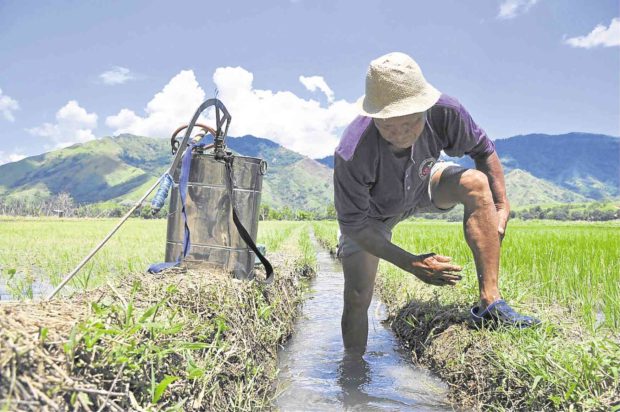
FREE-FLOWING Farmers like this rice grower in Aritao, Nueva Vizcaya, stand to benefit from the National Irrigation Administration’s free services, thanks to a newly enacted law. —MELVIN GASCON
Farmers with landholdings of 8 hectares or less are now exempt from paying irrigation service fees for using irrigation systems administered by the National Irrigation Administration (NIA).
Republic Act No. 10969, or the Free Irrigation Service Act, also condones these farmers’ loans and unpaid fees with the NIA.
In a media briefing on Friday, presidential spokesperson Harry Roque said Mr. Duterte signed on Feb. 2 the law “[which] would further relieve our farmers and their irrigation associations from the burden and consequence of unpaid irrigation service fees.”
Roque added that the law also “ensures that irrigation service is made available through the continued construction, repair and maintenance of necessary irrigation facilities.”
In the 2018 budget, the Department of Agriculture was allotted P2.67 billion for the construction, restoration or improvement of small-scale irrigation projects, and P4.28 billion for the construction of facilities and procurement of agricultural machinery and equipment.
Specific guidelines
NIA spokesperson Pilipina Bermudez said the President’s latest order would finally give the agency specific guidelines in providing free irrigation to small farmers.
“Our next step is to prepare an IRR (implementing rules and regulations) which may take us a month to finish, although we have already started. After that, we will present it to the President for approval,” Bermudez said.
Since January last year, NIA has been implementing the program but without the 8-hectare limit. The agency expects to put into effect the law’s new guidelines in a few months.
Farmers who own plantations and fishponds will now be subjected to irrigation fees based on the season, the crops planted and the buying price of the National Food Authority.
The fees can range from two to five cavans (of 50 kilograms each) per hectare.
In Pangasinan, a major rice-producing province which has 185,000 ha of farms, farmers have paid irrigation fees of up to P2,400 for every hectare, or the equivalent price of five cavans of palay.
RIVER SOURCE Stone terraces planted to rice in Sadanga town, Mountain Province, get their irrigation supply from the town’s many rivers, but it’s never enough. —EV ESPIRITU
Beneficiaries
Bermudez said the NIA had yet to finish updating its records to determine the number of farmers that would benefit from subsidized irrigation fees.
But according to Oscar Navata, NIA information officer in the Ilocos region, 116, 932 farmers and 102, 995 ha were expected to benefit from the new law.
The breakdown is as follows:
Pangasinan: 49,788 farmers/ 58,695 hectares
La Union: 19,647 farmers/ 10,610 hectares
Ilocos Sur: 24,352 farmers/ 13,748 hectares
Ilocos Norte: 23,150 farmers/ 19,942 hectares
The House version of the proposed measure sought to give all farmers free irrigation regardless of the size of their field, while the Senate version limited it to farms of only 5 ha and below.
In October last year, a congressional bicameral conference committee reconciled the two versions and decided that only farmers growing food on 8 ha of land or less would be entitled to free irrigation from the NIA. —WITH REPORTS FROM KARL R. OCAMPO AND INQUIRER ARCHIVES